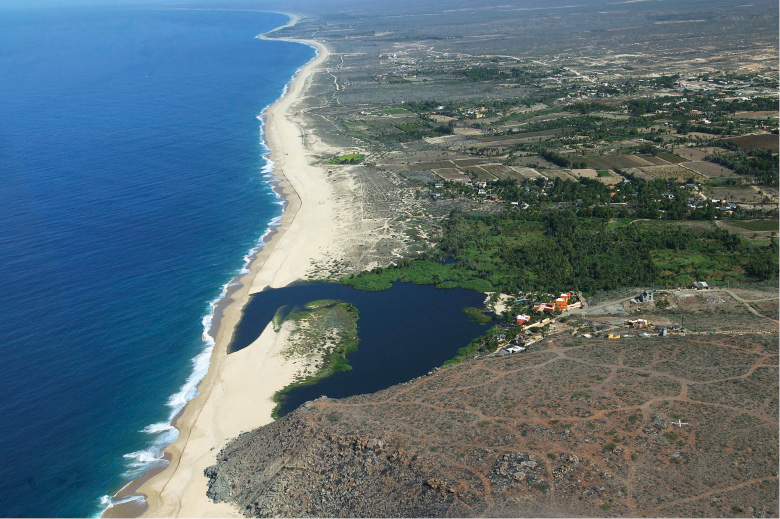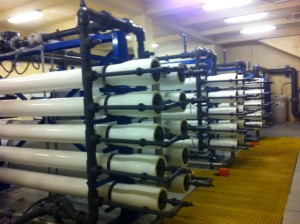by Bryan Jáuregui
La Paz is running out of water so it’s building an aqueduct to pump it in from El Carrizal. Los Cabos is running out of water so it’s contracting with a private desalination plant to boost supply. El Triunfo has water but residents refuse to drink it; it’s still contaminated by the arsenic released by mining operations at the turn of the last century. Baja California Sur is not only Mexico’s driest state*, but the country’s second fastest growing state by population. These two trends seem to be barreling towards a head-on collision that could take an enormous environmental, economic and public health toll on the state. Whether or not that collision takes place in the future depends largely on the actions we residents take today.
Gabriel Patrón Coppel is Coordinator of the Water Program at Niparajá, a non-profit dedicated to preserving the natural heritage of Baja California Sur (BCS), where freshwater management and use is one of three main programs. Gabriel believes that one of the key problems with respect to potable water in BCS is that residents have little knowledge of where their water comes from. “We conducted a study in 2009 and discovered that most La Paz residents didn’t know that the Sierra de la Laguna mountains are the source for the water that fills their aquifer, just as Sierra water fills the aquifers of Todos Santos and many of the Pacific communities of BCS. They therefore didn’t understand the need to protect the Sierras from outside threats such as gold mines, or internal threats such as soil erosion from overgrazing and illegal logging.” To address this situation, Niparajá launched two major campaigns to educate the citizens of La Paz about their water supply and the threats it faces: Defiende la Sierra la Laguna and “El agua no viene de la llave, viene de las Sierras, ¡Cuidalas!” (Water doesn’t come from the tap, it comes from the Sierras, take care of them!)
Arsenic and Old Mines
The most immediate external threat to the Sierras and the BCS water supply today—open pit gold mines planned by Canadian and American mining companies—is not a new issue. El Triunfo, currently a small town of about 300 souls and a well-loved pizza parlor, had a population of almost 3,500 in 1900 when it was a town teeming with the people and money attached to a large silver mining operation. There are some interesting monuments to that period of silver and gold-exploitation on the surface of the town, including a chimney designed by Gustav Eiffel of the eponymous Paris tower, and a museum that houses a vast collection of trophy pianos owned by wealthy families of the era. The enduring legacy under the surface is not so benign. Enrique Rochin Cota, director of the Los Planes-based organization Defense of the Environment and Sustainable Rural Development, explained the situation. “The Mexican government recently took samples from 80 wells around Los Planes and San Antonio. About half of those have arsenic contamination—from the 100 to 150-year-old mining waste—that is far above the permissible level for drinking water in Mexico. The really scary thing about all this is that these wells are still part of the water system. So not only have the contaminated wells not been shut down, there is now the imminent threat of mining in this area again. We are very afraid.”
Both Gabriel and Enrique referenced a recent study by Dr. Carlos Colin of the State Secretary of Health that confirms the presence of arsenic in the urine of local residents. Tanya Dimitrova, a reporter at the University of California, Berkeley School of Journalism, had a water sample from a Los Planes resident’s tap tested in the arsenic lab at UC Berkeley. In July 2013 she wrote that the sample “showed 53 parts per billion (ppb) arsenic—more than twice the concentration of arsenic allowed under the Mexican government’s standard.” The US drinking water standard is even stricter, only 10 ppb. Sadly, but perhaps not surprisingly, residents of Los Planes and San Antonio speak of high cancer rates in their towns, particularly among children.
Mining in the Sierras is strongly opposed by practically all the local politicians, business leaders and opinion-makers in BCS, including the governor and the local congress. So how is it possible for these foreign companies to hold concessions to mine gold in the Sierras? Easy. Mexico’s antiquated mining laws allow anyone to claim the right to Mexico’s mineral resources. The trick lies in getting their environmental impact assessment (the acronym is “MIA” in Spanish) approved by SEMARNAT, the environmental protection agency, and this is where citizens groups like Enrique Cochin’s Los Planes coalition and Niparajá’s Defiende la Sierra can exert their strength. Says Gabriel, “When the mines present their MIA, every citizen has the right to make comments. These mining groups have been trying for several years now to get the permits to begin blasting the Sierras to get at the gold, but the citizens have prevented it. Participation really does work.” Senator Carlos Mendoza Davis (a key player in the successful fight to win federal protection for Balandra Bay, see JDP Spring 2013) has introduced legislation that would permanently ban metallurgic mining in natural protected areas such as the Biosphere Reserve portion of the Sierra de la Laguna mountains. It’s a great start. It is up to the citizens of BCS to remain vigilant, and to continue to give their political leaders like Mendoza Davis, and their community organizers like Niparajá and Enrique Rochin, the support they need to defend each citizen’s most basic and fundamental right, the right to clean water.
“When the well is dry, we learn the worth of water.” Ben Franklin
Another key problem in the potable water issue in BCS is cost, with some residents paying nothing and some paying exorbitant fees. The problem with the former is particularly acute in La Paz. Currently less than 25% of the residential and commercial buildings in La Paz have meters, so the occupants have little or no economic incentive to conserve water. And without meters, there is often no way for residents to know if they have a leak, the result being that untold millions of unpaid-for gallons of water have simply evaporated out of La Paz. The city now faces an acute water shortage, with residents often going several days a week with no city water.
To address the issue, La Paz is building a 40 kilometer-long aqueduct to bring in fresh water from El Carrizal, “but that could easily dry up and is just a temporary solution,” says Gabriel. “If exploited sustainably, i.e., the rate of extraction is less than the rate of recharge, it could serve the city indefinitely. The problem is that the new aqueduct will only provide enough water for the current population of La Paz, and the city is growing rapidly with new immigrants, new hotels, new businesses. Once we deplete the aquifer at El Carrizal, there will not be another aquifer within a feasible distance from which we can extract more water to make up for the population increase.”
So what to do. The CEO of Mexico’s National Water Commission announced in mid-August that La Paz would join desert nations such as Saudi Arabia, Qatar and Libya and construct a seawater desalination plant in the city. Gabriel, like many scientists, environmentalists and economists, does not believe that desalination is the best long-term solution. He cites the enormous carbon emissions required to run a plant that then further degrade the environment and the quality of remaining natural water resources. He cites the hazards to marine life of the heavy brine discharge that desalination creates, as well as the increase in water costs to a non-wealthy population. Extensive papers have been written on each of these problems and more, and communities across the US and other nations struggle with them regularly.
Gabriel favors a two-pronged approach for La Paz: fix the leaks and metering issues in the municipal pipeline of La Paz, and increase the rate of replenishment for the aquifer. One of the key factors leading to low water levels in the aquifers of BCS is soil erosion in the Sierras caused by overgrazing of livestock and illegal logging. Without trees and plants to catch the rain when it falls, it simply evaporates on the surface and never makes it into the groundwater. Gabriel therefore advocates soil conservation. “Soil conservation works” he says. “We need to build filtration dams to return rainwater to the soil and get it back into the aquifer.” He notes that legislation banning the use of exotic plants that cannot survive on Baja’s meager rainfall levels should be passed as well.
Water, Water, Everywhere….
But these sustainable, long-term solutions can’t satisfy neighborhoods that perceive an immediate crisis, such as the one faced by the Pedregal of Cabo San Lucas in 2007. The city had only enough water to supply the Pedregal two to three days a week, so residents who wanted more water than that were buying it by the truck load. It’s been estimated that in one year 5,000 truckloads of water were delivered to this neighborhood of 650 homes. Homeowners finally got fed up and bought a solution that would provide better long-term water security. They built a desal plant.
Now it should be noted that the Pedregal occupies some of the highest-priced real estate in Baja, and features a large number of stunning homes. Members of the homeowners association that built the desal plant are people with means. They therefore hired a top-notch company out of Houston – Global H2O Investments – to design, build and manage the plant for them and they are thrilled with the results. They are not the only ones. OOMSAPAS, the water company, plans to contract with the Pedregal / Global H2O plant to provide water to downtown Cabo San Lucas (OOMSAPAS currently supplies the northwestern part of the city through its own desal plant). The Pedregal plant will be the first private facility in Baja to have a contract with a municipal water company to supply potable water to city residents. This has some interesting implications for Cabo water policy.
Two years ago the Cabo government mandated that all major new developments had to have their own desalination and wastewater treatment plants. The government had gone easy on developers in the early years, but too many developments had dried out too many estuaries and other natural water resources, and the government realized it would have to take action. As a result, desal plants have blossomed in Cabo. Carlos Hernandez, Operations Manager for the Global H2O / Pedregal plant, estimates that there are currently 30 desal plants operating in Cabo. Some developments, such as the El Dorado, now operate completely off the city grid with their own electricity, sewage treatment and water.
Apart from the unknown environmental impact of so many desal plants operating in such close proximity to each other, this type of utility self-sufficiency is fine for keeping well-funded companies that are making good returns from imposing on the municipal water supply. But in some cases, such as the El Mogote project in La Paz, developers have not been able to meet the water-autonomy commitments they made. El Mogote had committed to building a desal plant, but as funds grew scarce it looked for ways to retrench and soon a large water pipe was connecting the development in the bay to the city. Fortunately for La Paz, sadly for those who invested in El Mogote, the project failed and that extra burden on the city’s already-meager water resources was avoided.
It’s Chinatown, Jake
The old joke in China is that it will never have to invade Hong Kong to bend the western-leaning city to its will, it can just shut off the city’s water supply; 70% of Hong Kong’s potable water originates in the mainland. Water security for towns, cities, states and nations is tricky business and Baja is certainly not alone in its water woes. In Chinatown, the 1974 movie about a 1937 Los Angeles in which corporations are paying off officials to divert water to their projects, one of the characters has this to say about the Pacific Ocean. “Now you can swim in it and you can fish in it but you can’t drink it and you can’t irrigate an orange grove with it.” For wealthy communities desalination is increasingly the solution of choice to such problems, with demand for progressively scarce potable water outweighing any environmental concerns. For example, the San Diego County Water Authority agreed in February to buy water from the new desal plant in Carlsbad for $2,000 per acre-foot, which is twice the cost of available alternatives. While the hope is that costs will trend down over time, the Pacific Institute of California reports that desal plants on average use roughly 45% more electricity to produce fresh water than other options. In an area like Baja, with its fragile eco systems, large agricultural sector, and limited natural and financial resources, desalination is clearly not an option for all communities. So we must be vigilant in defending the Sierras, pro-active about replenishing the aquifers, and adamant about keeping even desal water available for all who need it, not just those who can afford it.
*BCS has an average of 160 mm of rain per year, compared to 760 mm of rain per year for the country as a whole.
To learn more about the threat to the Sierras and how you can help defend them, please go to Niparajá’s web sites devoted to this issue: www.defiendelasierra.org and www.niparaja.org/elaguaenlapaz.



